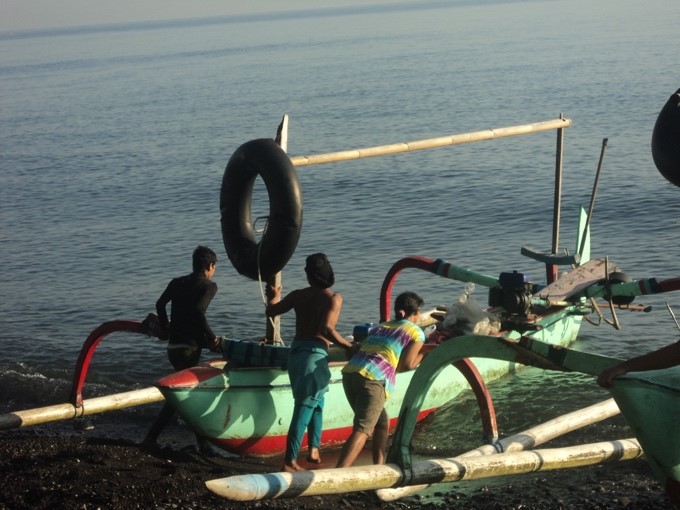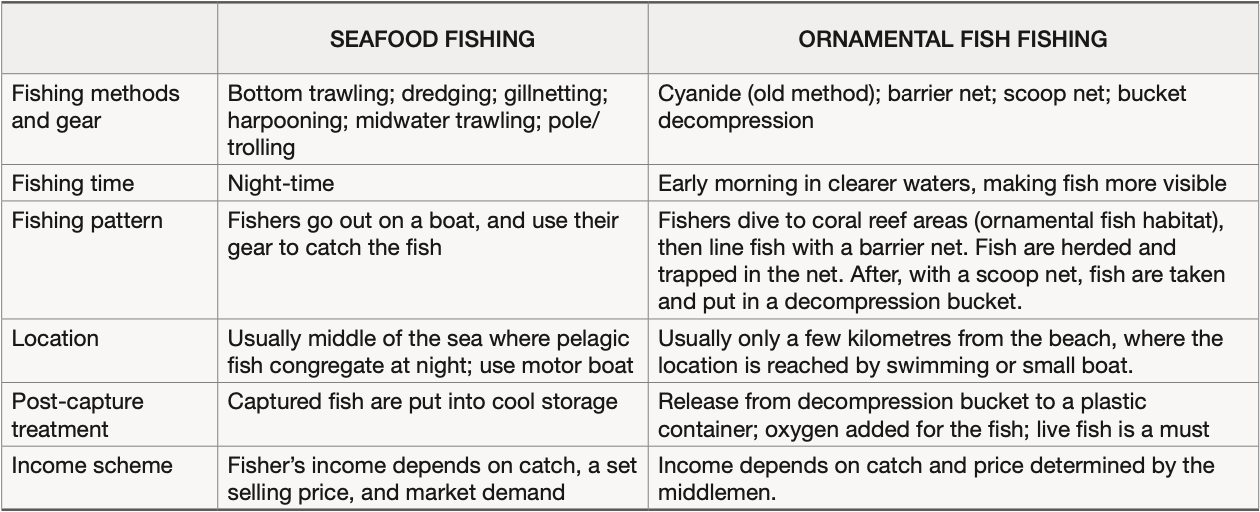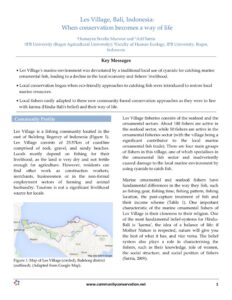
05 Jun Les Village, Bali, Indonesia
Humayra Secelia Muswar and Arif Satria
Key Messages
- Les Village’s marine environment was devastated by a cyanide traditionally used for catching marine ornamental fish, leading to a decline in the local economy and fishers’ livelihood.
- Local conservation began when eco-friendly approaches to catching fish were introduced to restore local marine resources.
- Local fishers easily adapted to these new community-based conservation approaches as they were in line with karma (Hindu-Bali’s belief) and their way of life.
Community Profile
Les Village is a fishing community located in the east of Buleleng Regency of Indonesia (Figure 1). Les Village consists of 25.57km of coastline comprised of rock, gravel, and sandy beaches. Locals mostly depend on fishing for their livelihood, as the land is very dry and not fertile enough for agriculture. However, residents can find other work as construction workers, merchants, businessmen or in the non-formal employment sectors of farming and animal husbandry. Tourism is not a significant livelihood source for locals.

Figure 1: Map of Les Village (circled), Buleleng district (outlined). (Adopted from Google Map)
Les Village fisheries consists of the seafood and the ornamental sectors. About 100 fishers are active in the seafood sector, while 50 fishers are active in the ornamental fisheries sector (with the village being a significant contributor to the local marine ornamental fish trade). There are four main groups of fishers in this village, one of which specialises in the ornamental fish sector and inadvertently caused damage to the local marine environment by using cyanide to catch fish.
Marine ornamental and seafood fishers have fundamental differences in the way they fish, such as fishing gear, fishing time, fishing pattern, fishing location, the post-capture treatment of fish and their income scheme (Table 1). One important characteristic of the marine ornamental fishers of Les Village is their closeness to their religion. One of the most fundamental belief-systems for Hindu-Bali is ‘karma’, the idea of a balance of life: if Mother Nature is respected, nature will give you the best of what it has, and vice versa. The belief system also plays a role in characterising the fishers, such as their knowledge, role of women, the social structure, and social position of fishers(1).
Conservation and Livelihood Challenges
Initially, nets were used to catch ornamental fish in Les Village. However, an increasing demand in the 1980s prompted the fishers to look for ways to improve their catch. In 1985, the cyanide method of fishing was introduced to support marine ornamental fish market demand(2,3,4). Fishers discovered that cyanide makes fish lethargic, thereby making them easier to catch(2,3). Fishers kept the cyanide in a bottle (Figure 2) and sprayed the cyanide in the ornamental fish habitats(4).

Table 1 Key differences between seafood fishing and ornamental fishing
Beginning in the 1990s and into the 2000s, marine ornamental fish began to be a lucrative commercial commodity. Fishers concentrated on fulfilling their household needs and generating income, while exploiting Mother Nature to satisfy marine oriental fish markets(5). The use of cyanide made fish easier to catch; however, environmental deterioration began to be felt by fishers in the 2000s. The use of cyanide negatively impacted the local marine environment as live coral coverage fell below 10%, ornamental fish population decreased to under 20% and population of all species decreased to an estimated 10% of their 1986 population(6).

Figure 2: Fisher sprays the cyanides directly to the reefs to make fish lethargic.
Coral reefs became bleached and only unique ornamental fish were left. Not being able to meet market demand, this development depleted fisher’s income and devastated their social and economic life. Lack of government concern created a sense of abandonment among marine ornamental fishers. Fishers said that the government is only punishing them because of their use of cyanide, but gave no instructions on how to change their ways or preserve the environment. Three reasons, in particular, relate to the root causes of the destructive fishing methods:
1. Fisher’s knowledge. Les Village fishers did not know of any other way to catch fish. Locals possessed limited information about fishing methods, especially since they have no senior high school or higher education. This concern was most frequently raised by fishers. Using cyanide had become transmissible knowledge. Fishers faced a dilemma to survive and had to choose to keep catching fish with cyanide or not be able to eat at all. The use of cyanide eventually became unlawful and Les Village fishers were often detained for violation of the law of using cyanide in an attempt to catch fish. Yet, the government offered no solution, without which fishers would continue to violate the law in order to support themselves and their families. The combination of lack of education and lack of guidance from the state thus established a livelihood dilemma for fishers.
2. Market demand. The ornamental fish trade is part of the global and international market, and whether wanted or not, local fishers are a part of globalised market system. To maintain a livelihood, they must meet a demand that comes from first-world countries. The greater the market demand – in this case, via the middlemen (Figure 3) – the more fish must be caught. Thus, Les Village fishers and the local environment are exploited and marginalized in order to meet the demand of more powerful countries and peoples(5).

Figure 3: the middlemen and the collected fish.
3. Lack of public and stakeholder awareness and involvement. The marine ornamental fish trade is part of international trade, which involves stakeholders. This means that capitalist industrialisation brings constant pressures on individual firms (big or small) to keep down costs(7). One of the main ways firms do this is by “externalizing” the costs of their impacts (including environmental, social, and health impacts) – in other words, finding a way to make someone else pay those costs. In fisheries, firms benefit from the environment – they profit from the fish – but they do not pay the full costs of the impact their fishing has on the local fisheries or the environment. In the case of Les Village, fishers were pressured to continue to use cyanide in order to meet market demand. Fishers were put in a difficult dilemma: wanting to conserve the environment when it began to degrade, but lacking the education to know the negative impacts of cyanide and, even worse, lacking support or knowledge about solutions. However, fishers continued to fish as they needed to support their livelihood. Others would profit from their environment and take whatever they conserved if they did not (5,7).
Community Initiatives
This situation continued for nearly 20 years. In the early 2000s, when reefs were already damaged and degradation reverberated, government still did not come to help; however, the NGO Yayasan Bahtera Nusantara (YBN) came and provided much needed support to the fishers. Originally engaging the fishers under the guise of a buyer, the YBN provided fishers with training and new equipment for environmentally friendly fishing, thus moving from cyanide to using nets and barriers only. The approach that the NGO helped to implement was particularly successful since it acknowledged the fisher’s belief system, thus helping Les Village fishers transform from the destroyer to the guardian.
The value of environmentally-friendly fishing that was implemented brought back fishers’ consciousness about the balance of life. They realized that using cyanide meant demolishing their own natural resources, since they suffered from the effects of using cyanide: diminished fish stocks, disappearing coral reefs, and heavy debt. Thus, Les Village’s ornamental fishing community worked with the NGO to restore their marine livelihood.
The initiative consisted of the following actions:
- Establishment of a new marine ornamental fish group that committed to ecologically-friendly fishing practices (no cyanide), and community-based marine environmental management.
- Creation of artificial reefs to enhance Les Village’s marine diversity.
- Designing a community-based no-take zone.
- Improvement of the belief that ‘karma’ does exist, and that “if we treat our nature good, nature will give us good fish”.
Around 2005, YBN worked with the Marine Aquarium Council (MAC) to legitimise the environmental-friendly transformation on marine ornamental fish trade in Les Village. Not only fishers, but also the middlemen and exporters were certified as eco-friendly actors. Although the certification expired in 2008, fishers continued to apply the sustainable eco-friendly fishing methods. Now, LINI (Indonesian Nature Foundations), an environmental NGO, works with Les Village fishers to continue this sustainable way.
Practical Outcomes
The success of this conservation movement by Les Village’s communities of marine aquarium fishers was a collective effort. Several factors and important actors were involved:
Leadership – The NGO’s leadership was the most powerful tool for motivating this community to move from using cyanide to using environmental friendly fishing practices.
Community Social Capital – The community has very high social capital and unity due to their interrelatedness and common history (Figure 4). Together, they inadvertently destroyed their marine environment, suffered, and are recovering their livelihood. Togetherness and trust is the biggest part of this community’s social capital.
Fisher’s Belief System – Their beliefs as Hindu-Bali teach them to put trust on ‘karma’.
Support Networks – The village has an extensive support network with NGOs, researchers (from universities) and trade chain actors that buy and sell their eco-fish.
Timing – The conservation was done just in time. The NGO came in at a critical ecological time, when fishers were getting more confused and frustrated from suffering from their sinking livelihood and questioning what they were doing to their environment.

Figure 4: Fisher’s family starts their day.
References
- Bryant, R. and Bailey, S. (1997). Third World Political Ecology. New York, USA: Routledge.
- Frey, J.B. (2012). A community-based approach to sustainable ornamental fishing on coral reefs, Bali, Indonesia. Master’s thesis (Natural Resources Management). Natural Resources Institute, University of Manitoba, Winnipeg, Canada. Available at: https://umanitoba.ca/institutes/ natural_resources/canadaresearchchair/thesis/James%20 Frey%20Master’s%20Thesis%20Dec%202012.pdf
- Mansfield, B. (2011). “Modern” industrial fisheries and the crisis of overfishing. In: R. Peet, P. Robbins, M. Watts (eds.), Global Political Ecology, Chapter 4. London, UK: Routledge.
- Muswar, H. and A. Satria. (2011). Impact of Fisheries Ecolabelling (Case Study: Les Village’s Ornamental Fish Fisher). Sodality: Transdisciplinary Journal of Sociology, Communication, and Human Ecology, December 2011, pp. 273–296. Available at: https://doi.org/10.22500/sodality. v5i3.9693 (in Bahasa Indonesia).
- Pasaribu-Guzina, S. (2013). Assessment of an Environmentally-Friendly Method of Ornamental Fishing Associated with Revenues of Fishers In Tejakula Sub- District, Buleleng Region, Bali, Indonesia. Master’s thesis (Environmental and Management). School of Environmental and Sustainability, Royal Roads University, British Colombia, Canada. Available at: http://hdl.handle.net/10170/641
- Satria, A. (2009). Fishers Political Ecology. Yogyakarta, Indonesia: LKis. ISBN: 9789791283885 (in Bahasa Indonesia).
- Sentosa, P. (2004). Sustainable Marine Ornamental Fish Business: A Case Study on How to Catch Cyanide to Non- Cyanide Ornamental Fish in Tejakula District, Regency, Bali). Master’s thesis (Environmental Science Studies). Graduate Program, University of Indonesia, Jakarta, Indonesia. Available at: http://lib.ui.ac.id/bo/uibo/detail. jsp?id=73982&lokasi=lokal (in Bahasa Indonesia).
Acknowledgements
The authors would like to thank Les Fishers Community and Dr Arya Hadi Dharmawan for their useful critiques, suggestions, support and insightful comments on this paper.



